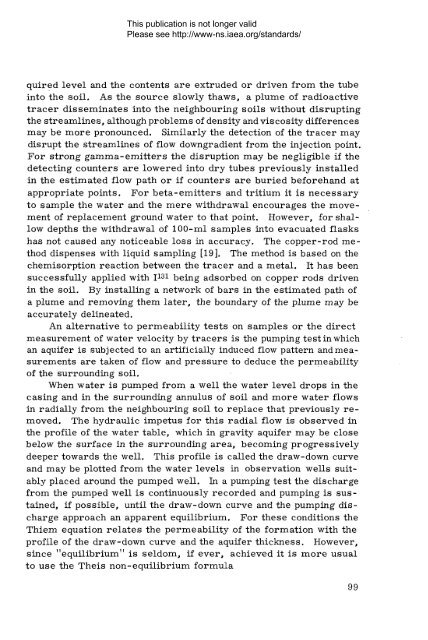Safety_Series_015_1965 - gnssn - International Atomic Energy ...
Safety_Series_015_1965 - gnssn - International Atomic Energy ...
Safety_Series_015_1965 - gnssn - International Atomic Energy ...
Create successful ePaper yourself
Turn your PDF publications into a flip-book with our unique Google optimized e-Paper software.
This publication is not longer validPlease see http://www-ns.iaea.org/standards/quired level and the contents are extruded or driven from the tubeinto the soil. As the source slowly thaws, a plume of radioactivetracer disseminates into the neighbouring soils without disruptingthe streamlines, although problems of density and viscosity differencesmay be more pronounced. Similarly the detection of the tracer maydisrupt the streamlines of flow downgradient from the injection point.For strong gamma-emitters the disruption may be negligible if thedetecting counters are lowered into dry tubes previously installedin the estimated flow path or if counters are buried beforehand atappropriate points. For beta-emitters and tritium it is necessaryto sample the water and the mere withdrawal encourages the movementof replacement ground water to that point. However, for shallowdepths the withdrawal of 100-ml samples into evacuated flaskshas not caused any noticeable loss in accuracy. The copper-rod methoddispenses with liquid sampling [19], The method is based on thechemisorption reaction between the tracer and a metal. It has beensuccessfully applied with I131 being adsorbed on copper rods drivenin the soil. By installing a network of bars in the estimated path ofa plume and removing them later, the boundary of the plume may beaccurately delineated.An alternative to permeability tests on samples or the directmeasurement of water velocity by tracers is the pumping test in whichan aquifer is subjected to an artificially induced flow pattern and measurementsare taken of flow and pressure to deduce the permeabilityof the surrounding soil.When water is pumped from a well the water level drops in thecasing and in the surrounding annulus of soil and more water flowsin radially from the neighbouring soil to replace that previously removed.The hydraulic impetus for this radial flow is observed inthe profile of the water table, which in gravity aquifer may be closebelow the surface in the surrounding area, becoming progressivelydeeper towards the well. This profile is called the draw-down curveand may be plotted from the water levels in observation wells suitablyplaced around the pumped well. In a pumping test the dischargefrom the pumped well is continuously recorded and pumping is sustained,if possible, until the draw-down curve and the pumping dischargeapproach an apparent equilibrium. For these conditions theThiem equation relates the permeability of the formation with theprofile of the draw-down curve and the aquifer thickness. However,since "equilibrium" is seldom, if ever, achieved it is more usualto use the Theis non-equilibrium formula99
















